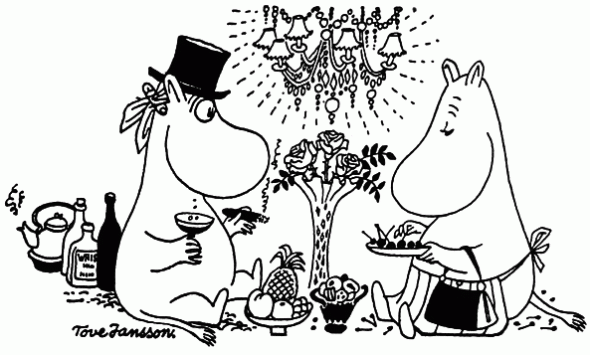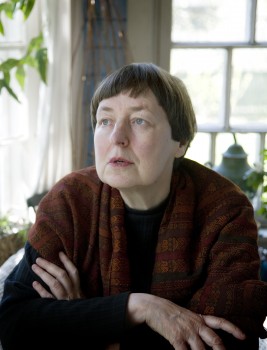Search results for "Tove"
Jansson’s temptations
27 November 2009 | This 'n' that

Tove Jansson (c. 1950)
If Tove Jansson’s Moomin books are, as we certainly believe here at Books from Finland, strangely little known in the wider world, the same is even truer of her books for adults.
Incredibly, the Moomins celebrate their 65th birthday in 2010, and have been translated into 40 languages. Jansson (1914–2001) wrote her last Moomin book – there are nine altogether – in 1970. Over the last thirty years of her life, she also wrote a total of 11 volumes – novels and short stories – for grown-ups. (Books from Finland published stories from many of them as they appeared. They will become available again as our digitisation project gets underway; meanwhile, here’s a story from Dockskåpet [‘The doll’s house’, 1978].)
Back out there in the wider world, the tiny, Hampstead-based press Sort Of Books has since 2001 been introducing Jansson’s lesser-known works to British readers. Latest to appear is her bleakly unsettling novel The True Deceiver (Den ärliga bedragaren, 1982), the story of a strange young woman, Katri, who breaks into an elderly artist’s house and attempts to befriend her, for reasons of her own. More…
Moomin food
19 August 2010 | In the news
A cookbook that introduces Tove Jansson’s famous Moomin family and other characters from the delightful classic stories for children (and adults), with original illustrations and quotations from the Moomin books, has been published in the UK.
Entitled Moomins’ cookbook. An introduction to Finnish cuisine (translated by David Hackston and published by SelfMadeHero), the book was compiled and written by Sami Malila and published in Finnish in 1993 (WSOY).
The Moomins are also currently being celebrated in an exhibition at the Design Shop UK in Edinburgh, entitled ‘And the World Went Mad for Moomins’. The exhibition runs until September 5.
Translations of books by Tove Jansson (1914–2001) have been published in more than 30 languages.
The cookbook offers recipes of healthy porridges and fish dishes, mushrooms and fresh berries, as well as treats like one of the Moomins’ favourites, pancakes (often cooked in the oven) with jam and whipped cream.
And as this is a cookbook for the whole family, Moominpappa’s grog contains no alcohol – but it’s no secret he enjoys a drop of good whisky (see the picture) every now and then, and a good cigar.
Smart Moomins
27 June 2012 | This 'n' that

From page to screen: Tove Jansson's classic
‘Here’s little Moomintroll, none other,
Hurrying home with milk for Mother,’
are the opening lines of Tove Jansson’s classic 1952 illustrated children’s tale of a sister lost and found, The Book about Moomintroll, Mymble and Little My, in the English poet and novelist Sophie Hannah’s beguiling translation. (Swedish original: Hur gick det sen? Boken om Mymlan, Mumintrollet och Lilla My; illustration: the Finnish version.)
The book has now been released as a smartphone app by the London publisher Sort Of Books and Helsinki’s WSOY in collaboration with the Finnish developer Spinfy.
At the tap of a finger, birds fly, forest creatures crawl up and down tree-trunks, flowers open and close, fish jump and hattifatteners wiggle. Unlike in the Japanese animated cartoons that have done so much to make the Moomins well-known worldwide, this is achieved without doing any violence to Jansson’s original graphics.
The app can be played either in text or, for very small children, read-to mode, voiced by the actor Sam West. Three more Moomin apps are scheduled for release later this year.
Funny stuff: best-selling books in February
13 March 2014 | In the news
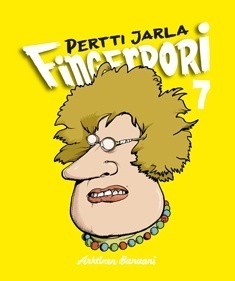 The list of best-selling books – compiled by the Finnish Booksellers’ Association – shows that in February comedy was popular among readers. Number one on the Finnish fiction list was Fingerpori 7 (‘Fingerborg 7’, Arktinen Banaani), the latest comics book by Pertti Jarla, featuring silly stuff taking place in the city of Fingerpori.
The list of best-selling books – compiled by the Finnish Booksellers’ Association – shows that in February comedy was popular among readers. Number one on the Finnish fiction list was Fingerpori 7 (‘Fingerborg 7’, Arktinen Banaani), the latest comics book by Pertti Jarla, featuring silly stuff taking place in the city of Fingerpori.
Riikka Pulkkinen’s new novel, a romantic comedy entitled Iiris Lempivaaran levoton ja painava sydän (‘Iiris Lempivaara’s restless and heavy heart’, Otava) which was originally published in a weekly women’s magazine, was number four. A satirical television series featuring two silly women devoted to dating and clubbing has also resulted in a book written by the two actresses, Heli Sutela and Minna Koskela: Anne ja Ellu lomamatkalla (‘Anne and Ellu on holiday’, published by Annen ja Ellun tuotanto) made its way to the seventh place. Number eight was Pertti Jarla’s Fingerborg 4!
However, number two was a first novel about problems arising in a religious family, Taivaslaulu (‘Heaven song’, Gummerus), by Pauliina Rauhala. Number three was a first novel by an immigrant Somali woman, Nura Farah: Aavikon tyttäret (‘Daughters of the desert’, Otava) tells the story of women in Somalia in the second half of the 20th century.
On the non-fiction list, among cookbooks and diet guides, books on how to maintain a hormonal balance or how to wield a kettlebell sold well. A new biography, Tove Jansson (Tammi), telling the life story of the Moomin genius (1914–2001), the artist, painter, author and cartoonist, was number seven; the author is Tuula Karjalainen. (The book will be published in several countries this year, a World English edition in December.)
At the top of the best-selling children’s books list is a book entitled Muumit ja tekemisen taika – ‘The Moomins and the magic of doing’ (Tammi). This ‘Moomin’ book is written by Clive Alan: we know absolutely nothing about him (he is absent from his publisher’s list of authors!) – except that the name is a pseudonym.
Well, as before, it is our opinion that all the Moomin books really worth reading were created by Tove Jansson herself.
New from the archive
9 April 2015 | This 'n' that
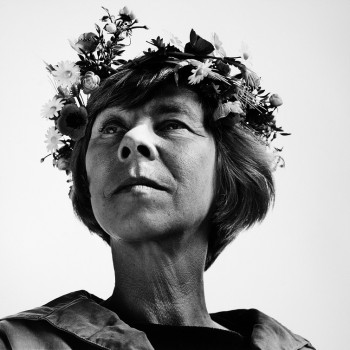
Tove Jansson. Photo: Hans Gedda
After she stopped writing the Moomin stories in 1970, Tove Jansson (1914-2001) began an entirely new career as the author of fiction for adults. This story, ‘Summer child’, comes from her third volume of short stories for adults, Resa med lätt baggage (Travelling light, 1988), where travelling – even if only by motor boat, between the islands of the archipelago that lies off Finland’s south-west coast – is the central theme.
‘Summer child’ tells the story of what happens when Elis, a morbidly serious little boy, spends the summer with a family in the Finnish archipelago. His gloomy world-view disquiets the cheerful Fredriksons to such a degree that in the end their differences can only be settled by violence….
*
The same story is republished, in a different translation, by Sort Of Books of London, with an introduction by the Scottish writer Ali Smith. For Smith, this tale of a young lad, ‘well-informed about everything that’s dying and miserable’, amid the idyllic landscapes of the Finnish summer, is ‘a fable about innocence and knowledge’; the book itself is ‘one of [Jansson’s] funniest, most unputdownably airy works’.
Ali Smith is far from being the only fan of Jansson’s work for adults. Sort Of Books has now published a total of seven volumes of her short stories, memoirs and novels, and her fame has also spread to the United States, where her Moomin books are much less well-known. Her The True Deceiver won the Best Translated Book Award in 2011, and has appeared on Publisher’s Weekly’s list of ‘The 20 Best Books in Translation You’ve Never Read’. It’s in good company – other books include Thomas Bernhard’s Concrete, Knut Hamsun’s Mysterie, Dubravka Ugresic’s The Museum of Unconditional Surrender and George Perec’s Life, A User’s Manual.
What’s translated?
14 March 2014 | This 'n' that

The database Finnish Literature in Translation, which details more than 7,500 works, with references to information on Finnish, Swedish and Sámi fiction and non-fiction translation, has been redesigned. Different search types are applicable, and the search results can be downloaded in Excel form.
Maintained and updated by FILI, the database offers information on book-length works as well as translation anthologies. Currently the oldest translation is from 1839. The database is trilingual: Finnish, Swedish, English.
So – if you’d like to know whether Tove Jansson’s Moomin books are available in your mother tongue, just look it up! (Tove can currently be read in 44 languages, from Albanian to Welsh.)
Moomins, and the meanings of our lives
21 December 2012 | This 'n' that
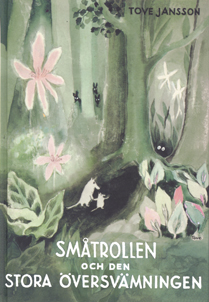
The first ever Moomin story, 1945
Tove Jansson’s Moomin books are widely cherished by children and adults alike. They are funny and charming yet haunting and profound. Lovable Moomintroll; practical and sensible Moominmama; spiky Little My; the terrifying yet complex monster, Groke – Jansson’s creations linger in the mind.
The first ever Moomin book – The Moomins and the Great Flood (Småtrollen och den stora översvämningen, 1945) – was published in the UK in October by Sort Of Books, but Jansson’s writing for adults is also achieving recognition in the English-speaking world.
A Winter Book, a selection of 20 stories by Jansson (Sort Of Books, 2006) was the trigger for a recent event on London’s South Bank. Along with journalist Suzi Feay and writer Philip Ardagh, I was invited to talk about Jansson’s work in general and about these stories in particular.
As Ali Smith notes in her fine introduction to the collection, the texts are ‘beautifully crafted and deceptively simple-seeming’. They are, as she puts it ‘like pieces of scattered light’. She also refers to the stories’ ‘suppleness’ and ‘childlike wilfulness’.
‘The Dark’, for example, offers an apparently random set of snapshots of childhood. Arresting images abound – swaying lamps over an ice rink, swirls in the pattern of a carpet that turn into terrible snakes – to create a tapestry of childhood. It’s like a dream: of ice and fire, fear and safety, a mixture that recalls the secure yet scary world of Moomin valley.
‘Snow’, too, conjures childhood fear. The house that features in this story is unhomely or uncanny, to refer to Freud, and seems haunted by the ghosts of other families. The story ends with the shared resolution between mother and child to return to a place of safety: ‘So we went home.’

Tove Jansson (1914–2001)
The combination of scariness and safety, of comfort and unease, is one of the things that makes Jansson (1914–2001) such a powerful writer, not only for children – although questions of security and fear might have especial resonance in early life – but also for adults, who continue to be haunted by the unknown, but also tempted by it.
The South Bank event also gave participants and audience the chance to talk about other works by Jansson. The Summer Book (Sommarboken, 1972) notably, is a delicate and deft evocation of a summer spent on an island.
The narrative charts the relationship between a grandmother and granddaughter, and at the same time probes such profoundly human questions as love and loss, hope and change and continuity. As always in Jansson, the descriptions are sharp and crisp, and the writing is at once spare and suggestive.
Novels like Fair Play (Rent spel, 1989) and The True Deceiver (Den ärliga bedragaren, 1982) reveal Jansson’s subversive, sly, and subtle sides, which sit alongside her playfulness, warmth, and humour to create a unique aesthetic. Fair Play is a book about the relationship between two women; it’s tender, funny and thoughtful. Never sentimental, it is nonetheless moving. And it’s quietly subversive in its matter-of-fact depiction of a same-sex relationship.
The True Deceiver is set in a snowbound hamlet. A young woman fakes a break-in at the house of an elderly artist, a children’s book illustrator, and a strange dynamic develops between the two women. It’s a book about being outside, about not belonging. The relationship between the women, which is never fully resolved or explained, is especially fascinating.
Jansson excels at showing the human need for both company and privacy, intimacy and autonomy. And her work is profoundly philosophical. In very light, nimble narratives, Jansson explores the meanings of our lives.
Ice hockey and grumpiness – popular books in September
16 October 2014 | In the news
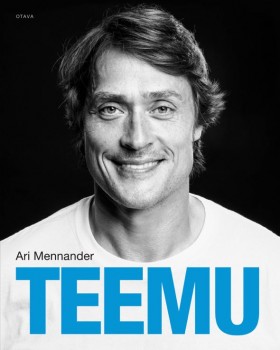
Ice hockey veteran: Teemu Selänne
The September list of best-selling non-fiction compiled by Suomen Kirjakauppaliitto, the Finnish Booksellers’ Association, included books on mushrooming: a popular pastime that, finding fungi for dinner. However, number one was the biography of the most internationally successful (NHL) ice hockey player so far, Teemu Selänne (recently retired), entitled Teemu (Otava).
Ilosia aikoja, Mielensäpahoittaja (‘Happy times, you who take offence’, WSOY) is the third book in the popular humorous series by Tuomas Kyrö, and it tops the September list of the best-selling Finnish fiction.
Kyrö’s protagonist, this mielensäpahoittaja, the one who ‘takes offence’, is a 80-something grumpy old man living in the countryside and opposing most of what contemporary lifestyles are about. For in the olden days everything was better: for example, food wasn’t complicated and cars were easily repairable.
Apparently Finns can’t get enough of this grumpiness. What began as short monologues written for the radio has become a series of books, and Kyrö’s Mr Grumpy has also appeared on the stage as well as on the screen: the first night of the film, also entitled Mielensäpahoittaja (directed by Dome Karukoski), took place in September. Will there be much more to come, we wonder.
Number two was the latest thriller by Ilkka Remes (pseudonym) with a book entitled Horna (‘Hell’, WSOY), and on third place was the new book by Anna-Leena Härkönen, a novel about a married couple who become lotto winners, Kaikki oikein (‘All correct’, Otava).
First place of the best-selling books for children and young people was occupied by the Moomins – not the original story books or comics by Tove Jansson though, but by other ‘Moomin writers’ and illustrators, whom there have been surprisingly many after Jansson’s Moomin art was made reproducible; this time the book is entitled Muumit ja ihmeiden aika (‘The Moomins and the time of wonders’, Tammi). Another cause of wonder, we think.
Hiroko Motai & Marika Maijala: Miljoner biljoner julgubbar [A million trillion Santas]
19 February 2015 | Mini reviews, Reviews
 Miljoner biljoner julgubbar
Miljoner biljoner julgubbar
[A million trillion Santas]
Translated from English into Swedish by Mirjam Ilvas
Kuvitus [Ill. by]: Marika Maijala
Helsinki: Schildts & Södersröms, 2014. 40 pp., ill.
ISBN 978-951-52-3422-3
€19.90, hardback
Miljoona biljoona joulupukkia
Suom. [Translated from English into Finnish by] Hannele Mikaela Taivassalo
Kuvitus [Ill. by]: Marika Maijala
Helsinki: Schildts & Södersröms, 2014. 40 pp., ill.
ISBN 978-951-52-3473-5
€18.90, hardback
Christmas-themed children’s books have a long tradition in Finland. Many new Christmas books appear every year to quench both children’s and adults’ Christmas fever. Japanese Tove Jansson fan Hiroko Motai (born 1972) approached Jansson’s Finnish publisher with her anarchic Santa Claus story with the hope that they would be interested in her idea. Motai’s story explains the miracle that happens every Christmas Eve: there are multiple Santas these days, because there’s no possible way that Santa could make it to the home of every child in the world in just one night. Versatile illustrator Marika Maijala has updated her image register by tightening up her earlier style. The rough chalk drawings brought to this reader’s mind drawings from her own school days. The sparse, naïve style is a excellent proof that a retro style can inspire an illustrator to create her own unique expressions.
Translated by Lola Rogers
Picture this
9 April 2015 | Articles
It’s impossible to put Finnish graphic novels into one bottle and glue a clear label on to the outside, writes Heikki Jokinen. Finnish graphic novels are too varied in both graphics and narrative – what unites them is their individuality. Here is a selection of the Finnish graphic novels published in 2014
Graphic novels are a combination of image and word in which both carry the story. Their importance can vary very freely. Sometimes the narrative may progress through the force of words alone, sometimes through pictures. The image can be used in very different ways, and that is exactly what Finnish artists do.
In many countries graphic novels share some common style or mainstream in which artists aim to place themselves. In recent years an autobiographical approach has been popular all over the worlds in graphic novels as well as many other art forms. This may sometimes have led to a narrowing of content as the perspective concentrates on one person’s experience. Often the visual form has been felt to be less important, and clearly subservient to the text. This, in turn, has sometimes even led to deliberately clumsy graphic expression.
This is not the case in Finland: graphic diversity lies at the heart of Finnish graphic novels. Appreciation of a fluent line and competent drawing is high. The content of the work embraces everything possible between earth and sky.
Finnish graphic novels are indeed surprisingly well-known and respected internationally precisely for the diversity of their content and their visual mastery.
Life on the block
Funny peculiar
9 December 2011 | Articles, Comics, Non-fiction

Samuel, the creation of Tommi Musturi (featured in Books from Finland on 7 May, 2010, entitled ‘Song without words’)
Comics? The Finnish word for them, sarjakuva, means, literally, ‘serial picture’, and lacks any connotation with the ‘comic’. The genre, which now also encompasses works called graphic novels, has been the subject of celebrations this year in Finland, where it has reached its hundredth birthday. Heikki Jokinen takes a look at this modern art form
Comics are an art form that combines image and word and functions according to its own grammatical rules. It has two mother tongues: word and image. Both of them carry the story in their own way. Images and sequences of images have been used since ancient times to tell stories, and stories, for their part, are the common language of humanity. The long dark nights of the stone age were no doubt enlivened by storytellers.
One of the pioneers of comics was the Swiss artist Rodolphe Töpffer. As early as 1837, he explained how his books, combinations of images and words, should be read: ‘This little booklet is complex by nature. It is made up of a series of my own line drawings, each accompanied by a couple of lines of text. Without text, the meaning of the drawings would remain obscure; without drawings, the text would remain without content. The whole gives birth to a sort of novel – but one which is in fact no more reminiscent of a novel than of any other work.’ More…
Favour and fame: becoming a best-seller
10 April 2014 | In the news
 At the top of the list of best-selling books – compiled by the Finnish Booksellers’ Association – in March was the first novel by Tommi Kinnunen, a teacher of Finnish language and literature from Turku. In Neljäntienristeys (‘The crossing of four roads’, WSOY) the narrative spans a century beginning in the late 19th century and is set mainly in Northern Finland, focusing on the lives of four people related to each other. Undoubtedly well-written, it continues the popular tradition of realistic novels set in the 20th-century Finland.
At the top of the list of best-selling books – compiled by the Finnish Booksellers’ Association – in March was the first novel by Tommi Kinnunen, a teacher of Finnish language and literature from Turku. In Neljäntienristeys (‘The crossing of four roads’, WSOY) the narrative spans a century beginning in the late 19th century and is set mainly in Northern Finland, focusing on the lives of four people related to each other. Undoubtedly well-written, it continues the popular tradition of realistic novels set in the 20th-century Finland.
Finland is a small country with one exceptionally large newspaper, Helsingin Sanomat (read by more than 800,000 people daily). The annual literary prize that carries the paper’s name is awarded to a best first work, and candidates are assessed throughout the year.
In February the paper’s literary critic Antti Majander declared in his review of Kinnunen’s book: ’Such weighty and sure-footed prose debuts appear seldom. If I were to say a couple of times in a decade, I would probably be being over-enthusiastic. But let it be. Critics’ measuring sticks are destined for the bonfire.’ More…

